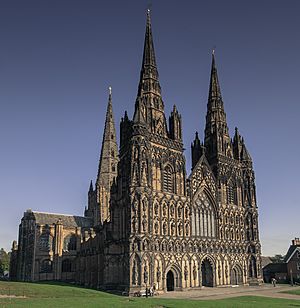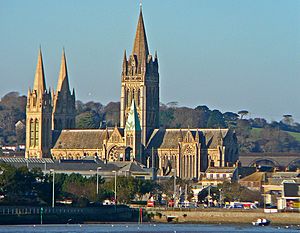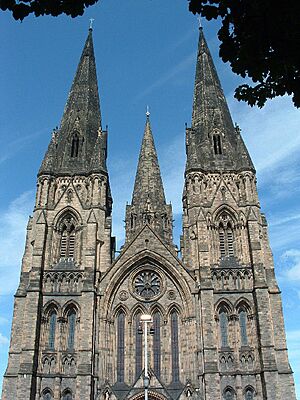Three-spired cathedrals in the United Kingdom facts for kids
The United Kingdom has only three cathedrals that have three spires. These special buildings are Lichfield Cathedral, Truro Cathedral, and St Mary's Episcopal Cathedral in Edinburgh. Lichfield Cathedral is the only one of these that was built in the Middle Ages (a long time ago, between the 5th and 15th centuries). For a while, Lincoln Cathedral also had three spires and was the tallest building in the world. However, its main spire fell down in 1549 and was never rebuilt. Truro Cathedral and St Mary's Episcopal Cathedral were built much later, in the late 1800s and early 1900s. They were designed in a style called Gothic Revival architecture, which copied the look of medieval buildings.
Lichfield Cathedral: A Medieval Marvel
Lichfield Cathedral is located in the city of Lichfield. This cathedral was built over many years during the 1200s and early 1300s. We don't know the exact dates for everything because many old records were lost during the English Civil War. The inside of the cathedral is about 113 meters (370 feet) long. The main part, called the nave, is about 21 meters (68 feet) wide.
The walls of the nave lean out a little bit. This happened because of the heavy stone roof. During some repair work, about 200 to 300 tons of stone were taken out to stop the walls from leaning more. The windows in the Lady Chapel have some of the most beautiful medieval glass from Flanders (now in Belgium). This glass was bought in 1801 when an old abbey was closed down. It was made in the 1530s. There are also lovely windows from the 1800s by artists like Betton and Evans, and Charles Eamer Kempe.
Lichfield Cathedral was like a strong fort during the English Civil War (1643–1646). It was surrounded by a ditch and defensive walls. The cathedral was attacked three times. In 1643, the Royalist side won one battle, and the Parliamentarian side won another. In 1646, the Parliamentarians won again. The cathedral was badly damaged. Its central spire was knocked down, the roofs were ruined, and all the stained glass was broken.
Lichfield Cathedral is special because it is the only medieval English cathedral that still has three spires. Its beautiful west front was fixed up a lot in the Victorian era by Sir George Gilbert Scott. He also designed St Mary's Cathedral in Edinburgh, which also has three spires.
Truro Cathedral: A Cornish Gem
Truro Cathedral is in the city of Truro in Cornwall, which is in south-west England.
This cathedral was built in the late 1800s, starting in 1879. It was built on the spot where an older church from the 1500s used to be. The design was created by a famous church architect named John Loughborough Pearson. His design was very much inspired by Gothic Revival architecture, which means it looked like old Gothic churches. The cathedral has three large towers and spires. The central tower and spire are 75 meters (250 feet) tall. The two spires on the western side are 60 meters (200 feet) tall.
The first foundation stones were placed in 1880. The first part of the cathedral was officially opened in 1887. The whole building was finally finished in 1910. Sadly, John Loughborough Pearson passed away in 1897, but his son, Frank Loughborough Pearson, continued his work.
St Mary's Cathedral, Edinburgh: A Scottish Story
St Mary's Cathedral, Edinburgh is a cathedral for the Scottish Episcopal Church in Edinburgh, Scotland.
In 1689, after King James VII/II left the throne, the church in Scotland split. Two different churches were formed. One was the Presbyterian Church, which was supported by King William. The other was the Scottish Episcopal Church, which stayed loyal to the old royal family, the House of Stuart. Because of this, St Giles' Cathedral in Edinburgh became part of the Presbyterian Church. This left the Episcopal Church in Edinburgh without its own cathedral. For a while, they met in an old building. Later, a church called St Paul in York Place served as their main church until the new cathedral was built.
The first stone for St Mary's Cathedral was laid on May 21, 1874. It was laid by the Duke of Buccleuch and Queensberry, whose family had supported the Scottish Episcopal Church for many years. Inside the stone, they placed a bottle with important papers, newspapers, and coins from that time. Before the cathedral opened, a group of people started meeting in a temporary iron church on the site. This group grew quickly. The main part of the cathedral, called the Nave, opened on January 25, 1879. Since that day, church services have been held there every day.
The two spires at the west end of the cathedral were started much later, in 1913, and finished in 1917. The architect for these spires was Charles Marriott Oldrid Scott, who was Sir George Gilbert Scott's grandson. These western spires are lovingly called "Barbara" and "Mary." They are named after Barbara and Mary Walker, two sisters who gave money to help build the cathedral starting in 1873. They owned land nearby and lived in a house north of the cathedral. Their family had a long history in Scotland.




